HSwMS Fylgia was the smallest armored cruiser in the world, a three-funnelled 4,800 tons ship with eight 6-in guns (152 mm) in four twin turrets fore, aft and admiships, which was rather innovative at the time. She was commissioned on 21 June 1907, served as cadet training in the interwar and then was comprehensively modernized prior to WW2. She was to be integrated in a new coastal fleet together with recent Swedish coastal Battleships, with Clas Fleming, leading squadrons of torpedo boats. Her major reconstruction lasted until 1940. During the war, she performed neutrality patrols, camouflaged with white bands on her hull. She also saw the early cold war, used as target ship and eventually decommissioned in 1953. By 1957 when she was scrapped, her hull was more than half a century old.
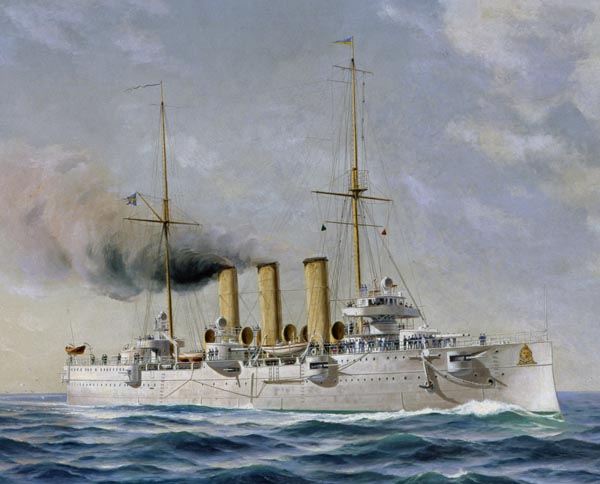
Painting of Fylgia
Development History
In 1892, the naval committee which already planned the torpedo cruisers also determined that the Swedish fleet needed two types of cruisers, a large and a smaller one. As often when submitted this, the riskdag (parliament) refuse the larger one and authorized the smaller one, which in fact became a serie of five torpedo cruisers we saw earlier. In 1901 however, a new committee was appointed to investigate again the fleet’s ship needs in a rapidly changing international context and after some feedback from the small torpedo cruisers were clearly insufficient, pointed at the larger cruiser option again. This was the only one that can solve the fleet’s tasks. The prospect was initially even more ambitious, looking for not one but several cruisers that could independently spy at sea, combat destroyers and light cruisers and be used as school ships in peacetime.
HSwMS Fylgia was first planned at the turn of the century, cruisers were pretty rare in Swedish naval history: In fact, apart the frigate Vanadis in 1862 and screw corvette Balder in 1870, there was no proper “cruiser” in the Swedish Navy for decades, at least a proper one. In 1896 through, a whole serie of torpedo cruisers, the örnen class, were the only exception. These five vessels built in 1894-1900 after the conclusion of the 1892 naval committee, displaced barely more than 800 tons and were essentially designed and used as torpedo boats leaders. However they were green water naval assets, clearly not fit for longer cruises, as befitting of a normal “cruiser”. So the Swedish admiralty looked for a large fleet vessel that can be used to “lead the leaders”, meaning these torpedo cruisers and all the flotillas as a naval HQ, with a sufficient level of protection and armament as a backup. It was still a largely coastal vessel intended for a defensive role, and thus, the Navy did not needed a long range, needlessly large and costly vessel. From there, specifications dictated a very unique ship, tailored for Swedish needs.
In 1902 at last, funds were granted for final design work and construction of a single new cruiser, while the same year an order was placed with Bergsunds Mekaniska Verkstads AB (Stockholm). The latter delegated construction work to its newly acquired Finnboda shipyard. In 1903, funding was requested for the construction of a sister ship, but this was denied by the parliament.
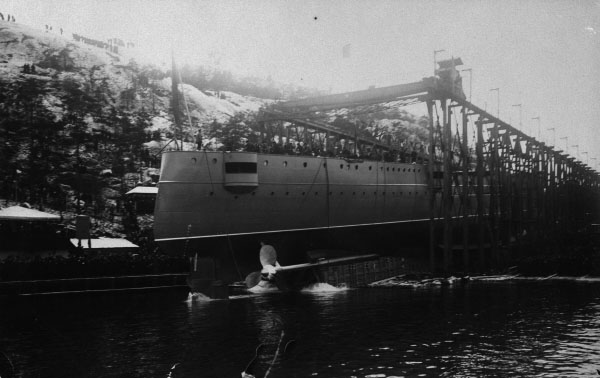
Launch of HSwMS Fylgia
Design
Hull & Protection
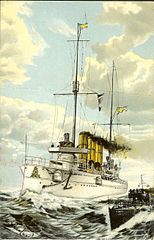 Fylgia was 115.1 meters long overall, to the tip of her ram, 14.8 meters wide and a draft of 5.1 meters. This was the size of an average German light cruiser of the time, not an armoured vessel. It even looked the part with her three raked funnels, two masts and sponsn artillery, typical forecastle and poop. It is hard from there to say for certain where influences layed, but certainly between British ang German ship design. Due to her armour, her standard displacement was 4,310 tonnes standard, 4,980 tonnes fully loaded, so much more than a light cruiser of equivalent size, closer to 3500 tonnes standard. All in all she was also an elegant ship, with a pointed stern, slight ram bow, three equally spaced, moderately tall funnels, and two also raked masts.
Fylgia was 115.1 meters long overall, to the tip of her ram, 14.8 meters wide and a draft of 5.1 meters. This was the size of an average German light cruiser of the time, not an armoured vessel. It even looked the part with her three raked funnels, two masts and sponsn artillery, typical forecastle and poop. It is hard from there to say for certain where influences layed, but certainly between British ang German ship design. Due to her armour, her standard displacement was 4,310 tonnes standard, 4,980 tonnes fully loaded, so much more than a light cruiser of equivalent size, closer to 3500 tonnes standard. All in all she was also an elegant ship, with a pointed stern, slight ram bow, three equally spaced, moderately tall funnels, and two also raked masts.
Behind and above her unique conning tower was built a small two-level (one enclosed, one open above) command and navigation bridge. As per usual visual conventions of the day, her hull was painted white, and the funnels, masts and air intakes and other “deck furniture” was painted in typical “canvas beige”. Decorum was kept minimal, there were just two small heraldry plaques at the bow with the Swedish Royal house symbology, painted blue and gold, her name at the stern and the usual officers open galley. She was built only for a crew of 322 men, of which 50 were cadets (so only 270), making her the least crewed armoured cruiser worldwide also, something helped in part by the armament’s choice.
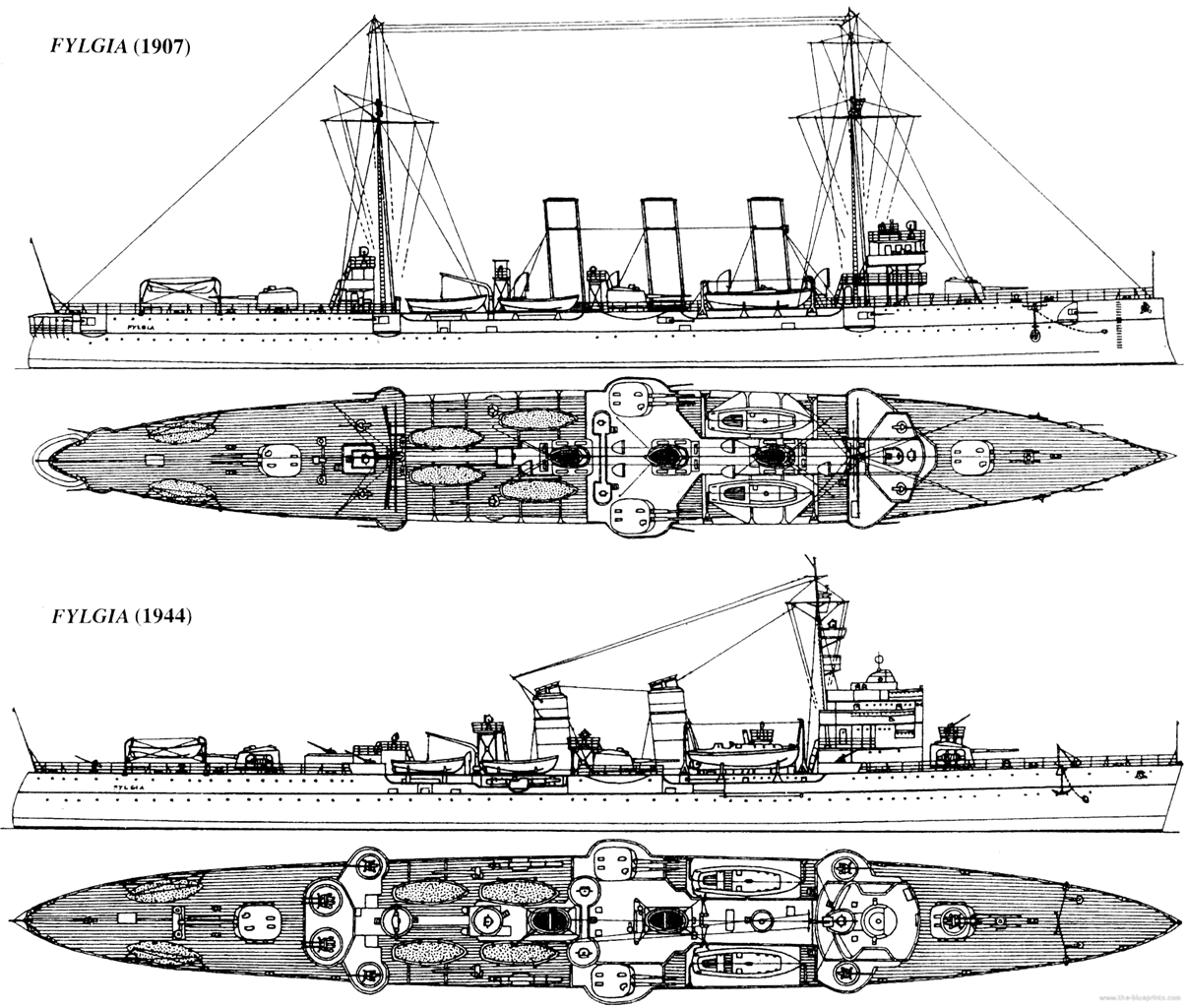
As a protected ship, Fylgia was given a sturdy hull, built of 22–35 mm thick riveted high carbon content Swedish steel. The core of her protection rested on a 50 mm (2.5 in) (at both ends), up to 100 mm (4 in) thick waterline armor amidship, extended about 50% of the hull’s lenght. So it was protecting the central machinery spaces and ammo storages, but not the fore and aft turret barbettes. It was also internal, not shown on the hull. Its lower edge was connected by 50 mm to the main deck slopes, and its flat section was only 22 mm thickness behind the belt (1.1 inches). The main deck outside the citadel was down to 35 mm in thickness (1.9 inches), still turtleback.
The armored deck was arched as per usual standards of the day, in true turtleback fashion. During construction, there was criticism in the admirakty (after all this was Sweden’s first such construction) that she would have poor stability, but at sea it would turn out she had good seaworthiness, turning radius and agility at large. Her turrets were protected by 130 mm of armour for the face (5 inches), down to 40 mm (2 inches) for the sides and roof. The ammunition hoists were protected by 100 mm thick walls.
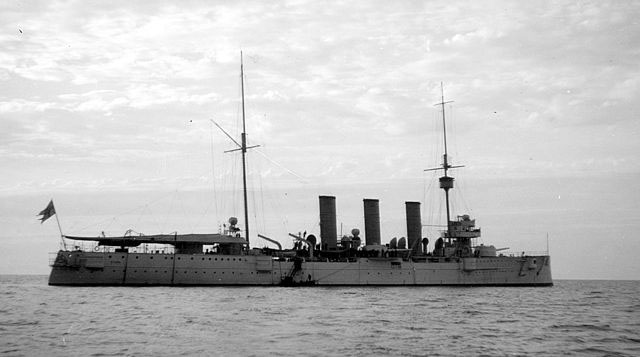
Powerplant
Fylgia was one of the last Swedish warships equipped with vertical, triple expansion, steam engines. She had two of them, fed by the steam produced in twelve coal-fired watertubes boilers, placed in three separate compartments. The two four-cylinder triple expansion engines drove a single propeller shaft each. Also, each separated boiler room’s four boilers had their pipes truncated into a single funnel, resulted in this “three pipes” appearance. This powerplant developed a total of 12,000 horsepower, making for a top speed of 22.77 knots (42 km/h) observed on trials, well above the estimated speed of 21.5 knots, also required in the navy specs. Still, 21 knots was not outstanding given the standards of the time, especially for a scout, but it was deemed sufficient at that time. Her coal stock was limited to 350 up to 900 tons maximum due to her small size, still providing her for a very generous 8,000 nautical miles at 10 knots. She was noted as a good steamer also. All in all Fylgia “looked right” and she certainly behaved that way.
Armament
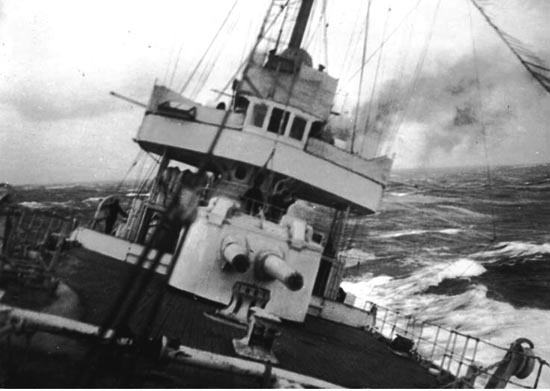
Fylgia in a severe storm, listing, and showing her forward turret
Main artillery:
Fylgia’s main artillery was another strong selling point of the design; She had eight 15.2 cm cannons m/03 (6 inches), but instead of having them in individual mounts, in tandem fore and aft and sponsons, she had all eight grouped into twin turrets. It was no unusual for armoured cruisers though, but in this case, even size guns were mounted in broadside turrets, so bow, stern, and amidships, a “lozenge” configuration allowing six guns in chase, retreat and broadside. Front armor was 125 mm thick and sloped and the mounts were manually traversed, as well as the barrel elevation, individually. The artillery officer from its position in the mainmast fighting top, directed fire via an acoustic tube.
Light artillery & torpedoes:
Secondary artillery was homogeneous, and consisted of fourteen 57 mm cannons m/89B (12 pdr) placed in four casemates on the broadside at the battery deck edges, in enclosed sponsons, two amidship, four more forward and aft of the hull’s Forecastle and poop and deck guns front and aft of the bridge. In addition, there were two 37 mm m/98B for saluting also amidships. There was also a forward torpedo room with just two 45.7 cm underwater torpedoes of the m/04 type.
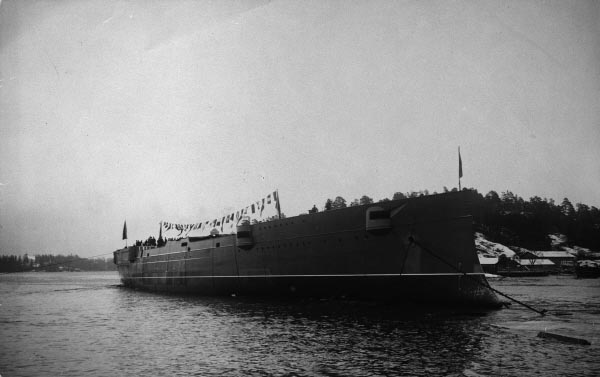
Fylgia, after launch, pending completion.
⚙ Specifications 1907 |
|
| Displacement | 4,734t standard, 4,900t FL |
| Dimensions | 115.10 x 14.78 x 6.30 m (383 ft 10 in x 48 ft 7 in x 20 ft 8 in) |
| Propulsion | 2 shafts, TE engines 12,000 ihp (8,900 kW) |
| Speed | 22 knots (41 km/h) |
| Range | 8,000 nmi (15,000 km) at 10 knots (19 km/h) |
| Armament | 8 x 6 in/50, 14 x 6-pdr, 2-in TTs |
| Armor | KC, KNC, 4 in belt and 5in-2in turrets |
| Crew | 320 (50 cadets) |
Refit 1939-40
Modernization designs were proposed as early as 1935, and in 1936 a plan as accepted, but rejected by the Riskdag. It was rejected again in 1937 and 1938, before growing international tensions changed the context. After being postponed for so many years, the summer of 1939 saw the parliament voting a budget for the complete reconstruction and overhaul of HMS Fylgia. The admiralty planned the cruiser would be part of the west coast fleet after that, with its own close protection group.
The modernization was one of the most ambitious and thorough of that time. Fylgia was drydocked for almost two years. Her superstructures were dismantled, her deck gutted as well as her battery and protective decks, in order to access to her machinery spaces.
-Her powerplant was partly modernized: She kept her VTE engines, but all her twelve coal-fired boilers were removed, and replaced by four large oil-fired Penhoët boilers. The boiler room No1 was rebuilt as a cadet accommodation area. The truncated exhausts had her funnels down to two, altering her appearance.
-The ram was eliminated and the bow reshaped into a semi-clipper variant, making her longer.
-The bridge structure was entirely rebuilt, and the CT eliminated. It was much roomier as a result, and inspired by Swedish destroyers of the time.
-Main artillery was modernized: She kept all her eight main guns in turrets, but with a new gun cradle, new barrel, new relload mechanism and new, more powerful ammunition. As a result, her main guns new had a firing range of 16,000 meters.
-The central fring direction was modernized too, with modern fire control systems and telemeters.
-All the electrical circuitry and subsystems, the communication network, were also entirely modernized.
-New electrical supply based on modern diesels, feeding generators and more powerful batteries.
-New wireless radio sets, many compartments modified.
-All former 57 mm guns replaced by:
> Four 57 mm Bofors w/98B-38B AA
> Four twin gyro-stabilized 40 mm automatic w/36 Bofors guns
> Four single 25 mm automatic w/32 Bofors
> Two twin 20 mm automatic AA gun.
-The two fixed underwater torpedo tubes were replaced by swiveling 533 cm tubes on opposite sides of the deck.
The diversity of armament was on purpose: It was to help the cadets familiaizing with all guns types in service with the Swedish Navy.
⚙ Specifications 1940 |
|
| Speed | 26 knots (50.9 km/h; 31.6 mph) |
| Armament | 6 x 152 mm (2×2, 2×1) 6-in -4x 75 mm (3 in) -4x 25 mm AA (1.2 in) -4x 2 40mm AA -2x 2 20mm AA |
| Crew | circa 480 |
HSwMS Fylgia in service
HMS Fylgia was launched on December 20, 1905, completed and commissioned on 20 June 1907. She was the Swedish fleet’s largest ship to date, and yet the world’s smallest armored cruiser. Fitting out work took longer than expected due to a strike, in fact, planned initially to early 1907. This summer, Fylgia started right away in a “shakedown cruise” to the Caribbean sea and United States coastal waters. In fact she would make ten long journeys until the First World War broke out. In 1913, her stern casemate were removed to provide better crew accommodation and those in the bow would be also removed soon. The foremast was reinforced and mounted a military lookout. After a firing incident, vulnerable aft 57 mm cannons were also relocated. On February 7, 1913 Fylgia ran aground off Karlskrona. This took place near Kurrholmarna, in Karlskrona’s inner archipelago, and fortunately nobody was injured and damage was minimal. After being towed away she resumed service.
The Great War
When World War I broke out, Fylgia was underway to the Mediterranean. At her first stop, news came in and her cruise was cancelled. She wa scalled back home to perform guarding patrols, enforcing the coastal national neutrality zones, under command of Captain Fredrik Riben. On several occasions she spotted, warned and fired upon foreign warships travelling through these areas and Swedish waters, all repelled. In the autumn of 1915 Fylgia led the only Swedish ship convoy ever during this war, and in 1916, her old aft 57 mm (12 pdr) guns were replaced with new 57 mm AA guns from Bofors. After the war ended, the Swedish admirakty devised a brand new plan for the coastal fleet. There was to be a main force including three new armored ships, well protected by several layers of smaller ships each, so three task forces or flotillas. One such plans included Fylgia, Fleming working together with a screen of destroyers, closest to the main force, and ten torpedo boats for close protection. Discussions went on but nothing changed for Fylgia.
HSwMS Fylgia’s interwar career
In 1919, Fylgia departed made her first postwar trip as a naval cadet training vessel, to the Caribbean, and the West coast of the United States. During the decades between wars she undetook no less than 20 of such cruises, without notiable incident, before was disarmed in 1933, docked in Karlskrona pending her fate. By then, the venerable cruiser was in poor conditions and obsolete. She was transferred to the reserve fleet to be investigated by a commission in charge or evaluating her fate, scrapyard or modernization, and to which degree. The team soon stated the boilers were completely outdated, and the armament and its attached fire control systems were also completely out of date. Discussions went on but it was decided to keep and modernize her was on paper less costly than building a brand new ship. Her interwar captains were Gunnar Unger (1919-1920), Claës Lindsström (1922–1923), Nils Åkerblom (1925–1925 & 1927–1928), Arvid Hägg (1925–1926), Lave Beck-Friis (1931–1932) and Magnus von Arbin (1933–1934). For the refit details, see above.

Fylgia in 1941 after completion, with her first baltic grey livery and white bands, later changed for camouflage.
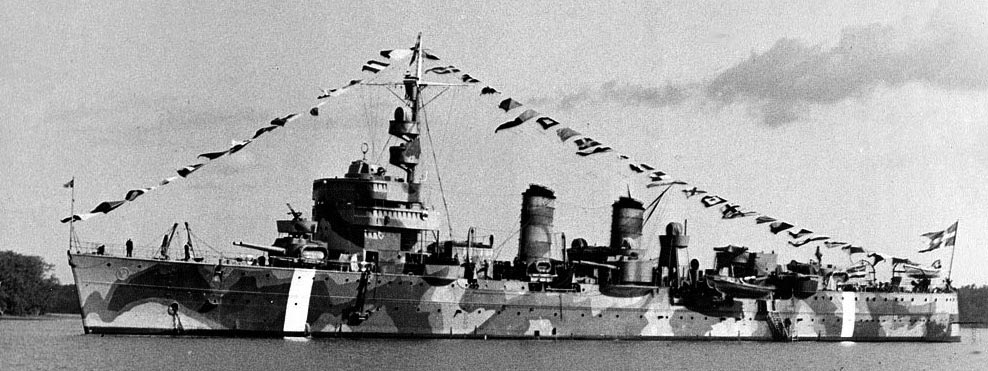
Fylgia, camouflaged in 1943-45
WW2 service
Fylgia’s reconstruction took the full year of 1940 and went on until early 1941. By then she started her post-refit trials, fixes in dock, and training with partly new recruits in order to gain operational status. After this she was assigned to the Gothenburg Squadron, in late autumn 1941. She belonged to the Gothenburg Squadron until 1944/45 and reorganization of the Swedish fleet, but she was retook also in 1942-45 her role at the naval school department for training, and during the winters, still traveled along the Swedish coast with officer cadets.
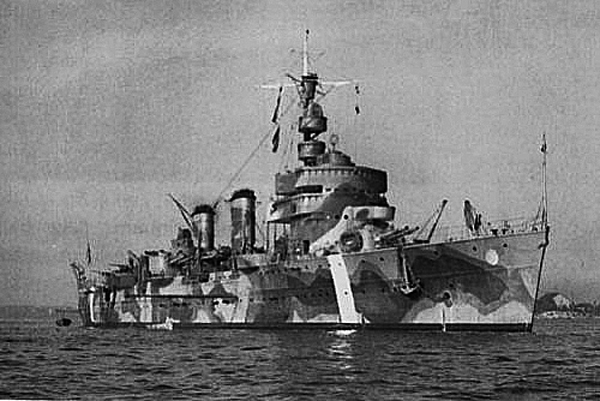
Fylgia during WW2
Post-WW2 service
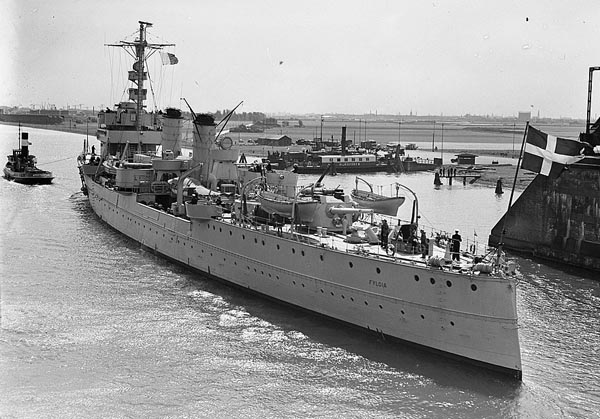
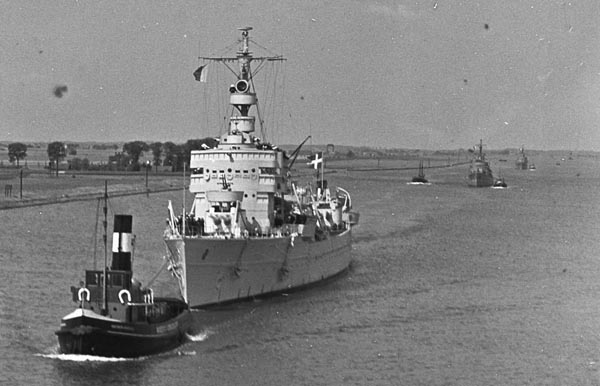
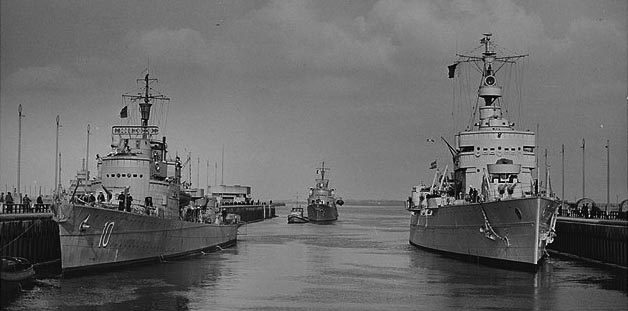
Fylgia in Amsterdam, 1948
HMS Fylgia after the war went on as the fleet’s main training ships for cadets, and resumed her long trips abroad. The feature film “The Navy’s Cavaliers” was shot in connection in 1948 during her long journey under command of Gunnar Fogelberg. Fylgia cruised each year, often twice, before the winter season and her service back in coastal waters plus yearly maintenance, until 1953, so for nine years during the cold war. Eventually the admiralty recoignised her slow speed was a disadvantage in wartime and she was still too cramped as a training vessel. She was discarded on 1st January 1953, mothballed, and from January 30, 1953 she was disarmed. Useful equipment was landed, her artillery moved to the Kalix fortification line in Norrbotten, placed near the village of Siknäs, in 1960. Special blockhouse and facilities were created to operate them. Two such turrets were condemned and blasted for safety after their closure in the early 2000s, but the main facility with another other turrets and liaison center remained, now part of the Siknäsfortet museum. The last one was sealed, but is also part of the museum’s exhibition.
Meawnhile, the hull also found its usefuless. After some minor modifications for the task, she was converted as a target hulk. She was repeatedly fired upon by the last generation of Swedish destroyers and cruisers (such as the Göta Lejon class) but also by coastal artillery. She was it was hit many times, but always refused to sink. Eventually, the old vessel was sold in 1957 for 418,157 crowns (approx. 5.77 million by 2009) to a scrapyard at Gothenburg near Copenhagen.
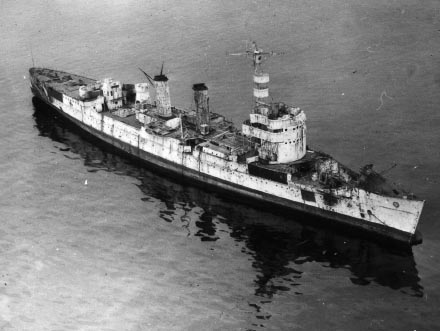
Fylgia as a target ship, 1955
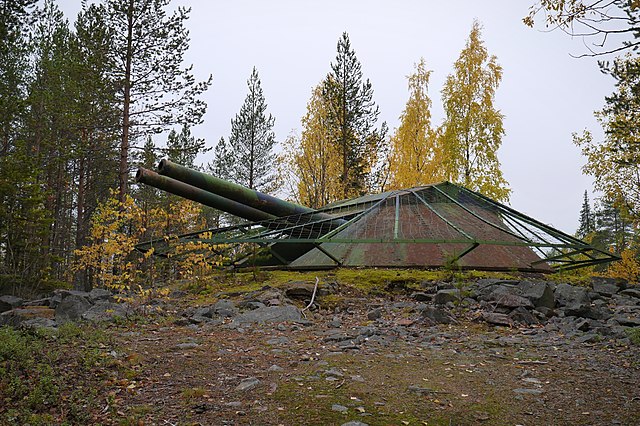
Salvaged turret, recycled into a naval fortification, still listed as “reserve”.
Read More & Src
John Gardiner, Conway’s all the world’s fighting ship 1860è1905, 1906-1921, 1922-47.
Borgenstam, Curt; Insulander, Per; Åhlund, Bertil (1993), Kryssare : med svenska flottans kryssare under 75 år
Lagvall, Bertil (1991), Flottans Neutralitetsvakt 1939-1945, Karlskrona: Marinlitteraturföreningen nr 71
von Hofsten, Gustav; Waernberg, Jan (2003), Örlogsfartyg: Svenska maskindrivna fartyg under tretungad flagg (1:a), Karlskrona: Svenskt Militärhistoriskt Bibliotek
On navypedia
Nice colorized photo by Frank, Fylgia saluting 1928; Maritime Museum in Stockholm (Fo229116).
Additional photos WT
wiki SE
Swedish history museum
On digitaltmuseum.se
The models corner
1:100 brass wood model at the Baltic sea Museum
shapeways 1:700
1/1250 model (pdf)

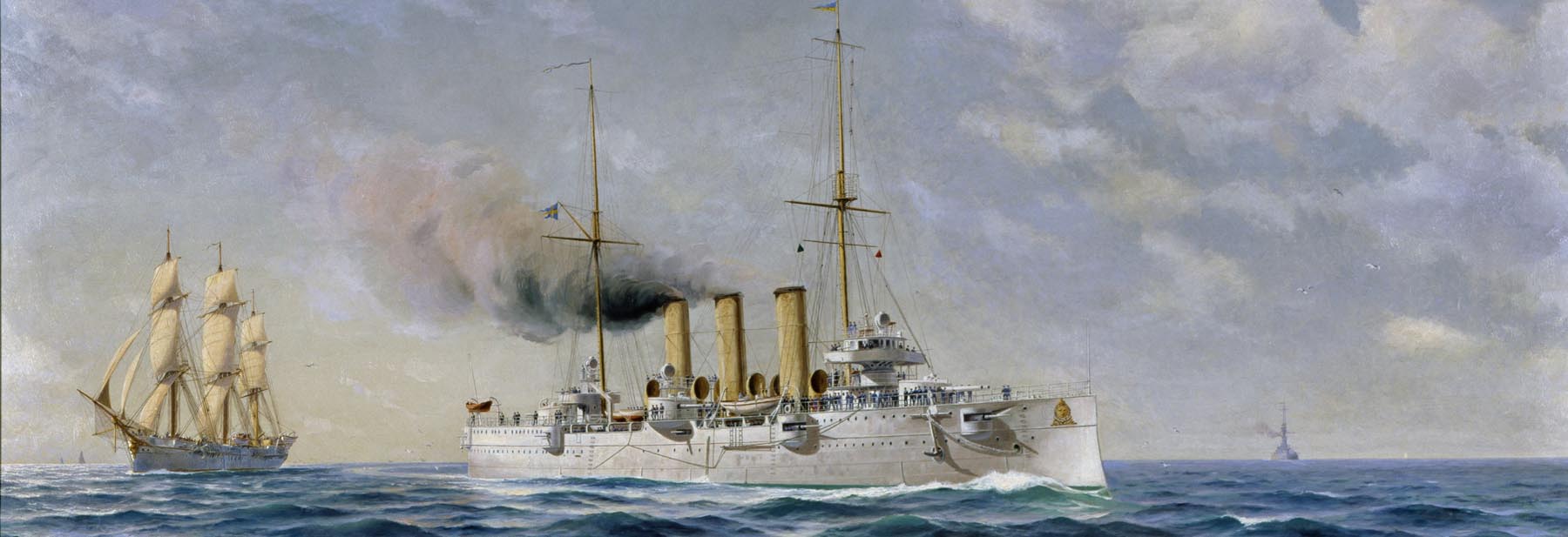

 Latest Facebook Entry -
Latest Facebook Entry -  X(Tweeter) Naval Encyclopedia's deck archive
X(Tweeter) Naval Encyclopedia's deck archive Instagram (@navalencyc)
Instagram (@navalencyc)





 French Navy
French Navy Royal Navy
Royal Navy Russian Navy
Russian Navy Armada Espanola
Armada Espanola Austrian Navy
Austrian Navy K.u.K. Kriegsmarine
K.u.K. Kriegsmarine Dansk Marine
Dansk Marine Nautiko Hellenon
Nautiko Hellenon Koninklije Marine 1870
Koninklije Marine 1870 Marinha do Brasil
Marinha do Brasil Osmanlı Donanması
Osmanlı Donanması Marina Do Peru
Marina Do Peru Marinha do Portugal
Marinha do Portugal Regia Marina 1870
Regia Marina 1870 Nihhon Kaigun 1870
Nihhon Kaigun 1870 Preußische Marine 1870
Preußische Marine 1870 Russkiy Flot 1870
Russkiy Flot 1870 Svenska marinen
Svenska marinen Søværnet
Søværnet Union Navy
Union Navy Confederate Navy
Confederate Navy Armada de Argentina
Armada de Argentina Imperial Chinese Navy
Imperial Chinese Navy Marinha do Portugal
Marinha do Portugal Mexico
Mexico Kaiserliche Marine
Kaiserliche Marine 1898 US Navy
1898 US Navy Sovietskiy Flot
Sovietskiy Flot Royal Canadian Navy
Royal Canadian Navy Royal Australian Navy
Royal Australian Navy RNZN Fleet
RNZN Fleet Chinese Navy 1937
Chinese Navy 1937 Kriegsmarine
Kriegsmarine Chilean Navy
Chilean Navy Danish Navy
Danish Navy Finnish Navy
Finnish Navy Hellenic Navy
Hellenic Navy Polish Navy
Polish Navy Romanian Navy
Romanian Navy Turkish Navy
Turkish Navy Royal Yugoslav Navy
Royal Yugoslav Navy Royal Thai Navy
Royal Thai Navy Minor Navies
Minor Navies Albania
Albania Austria
Austria Belgium
Belgium Columbia
Columbia Costa Rica
Costa Rica Cuba
Cuba Czechoslovakia
Czechoslovakia Dominican Republic
Dominican Republic Haiti
Haiti Hungary
Hungary Honduras
Honduras Estonia
Estonia Iceland
Iceland Eire
Eire Equador
Equador Iran
Iran Iraq
Iraq Latvia
Latvia Liberia
Liberia Lithuania
Lithuania Mandchukuo
Mandchukuo Morocco
Morocco Nicaragua
Nicaragua Persia
Persia San Salvador
San Salvador Sarawak
Sarawak Uruguay
Uruguay Venezuela
Venezuela Zanzibar
Zanzibar Warsaw Pact Navies
Warsaw Pact Navies Bulgaria
Bulgaria Hungary
Hungary

 Bundesmarine
Bundesmarine Dutch Navy
Dutch Navy Hellenic Navy
Hellenic Navy Marina Militare
Marina Militare Yugoslav Navy
Yugoslav Navy Chinese Navy
Chinese Navy Indian Navy
Indian Navy Indonesian Navy
Indonesian Navy JMSDF
JMSDF North Korean Navy
North Korean Navy Pakistani Navy
Pakistani Navy Philippines Navy
Philippines Navy ROKN
ROKN Rep. of Singapore Navy
Rep. of Singapore Navy Taiwanese Navy
Taiwanese Navy IDF Navy
IDF Navy Saudi Navy
Saudi Navy Royal New Zealand Navy
Royal New Zealand Navy Egyptian Navy
Egyptian Navy South African Navy
South African Navy






























 Ukrainian Navy
Ukrainian Navy dbodesign
dbodesign